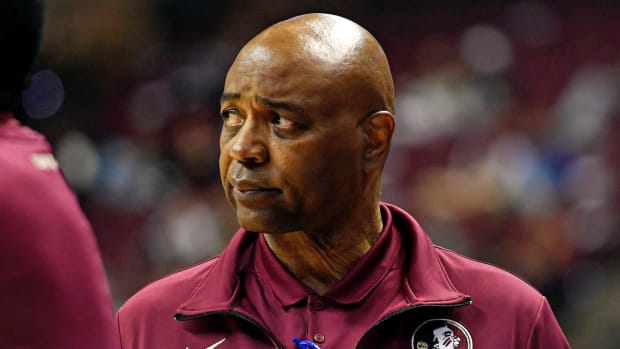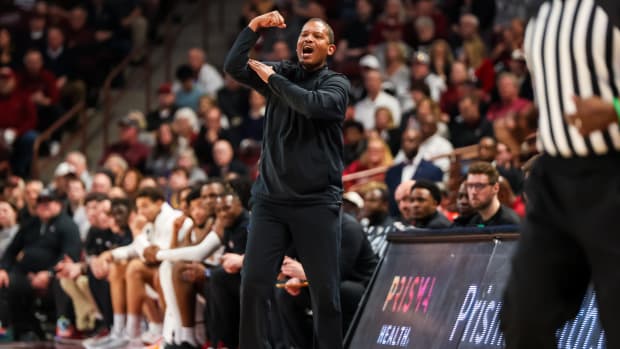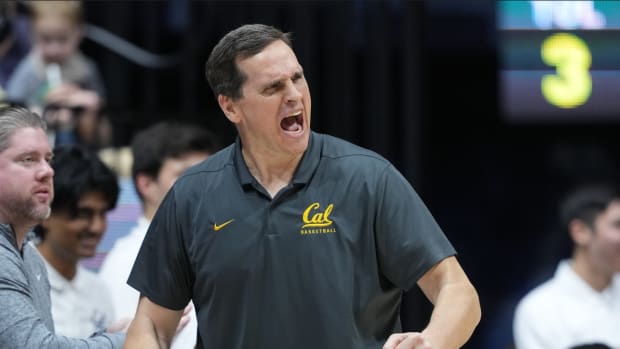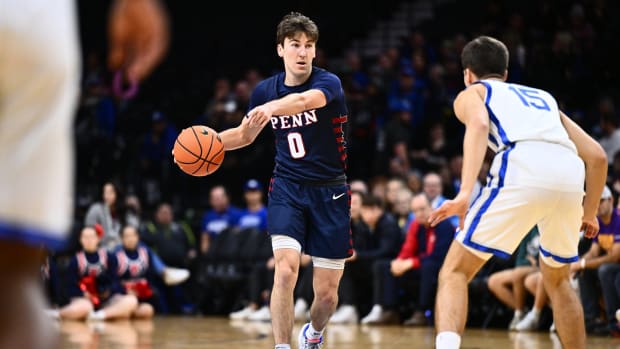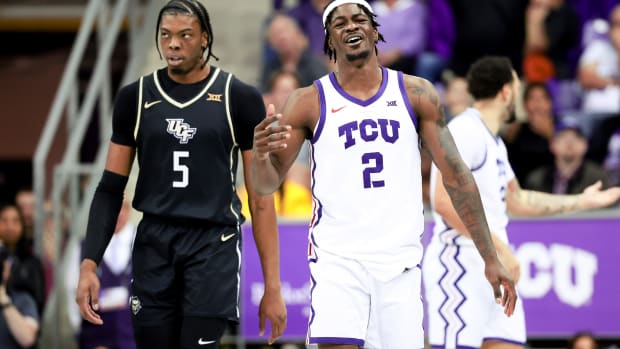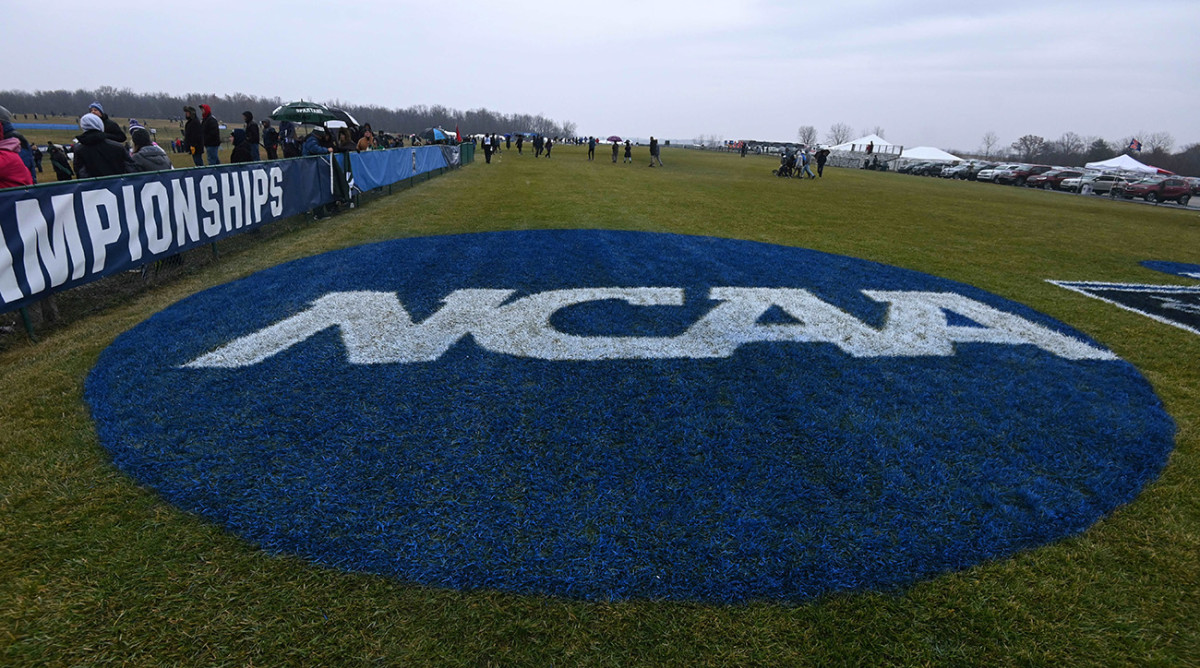
The NCAA's Independent Accountability Resolution Process is Another Hindrance to Progress
The latest spasm of scandal within the perpetually twitchy-sketchy University of Louisville basketball program caused everyone in college hoops to wonder: what will this mean for the Cardinals’ ongoing NCAA investigation? The simple answer: nobody knows for sure, because the case was consigned to the association’s equivalent of the dead letter office, where nothing ever happens.
The Independent Accountability Resolution Process, conceived more than three years ago by the Condoleezza Rice-led commission on college basketball and implemented 21 months ago, has accomplished nothing. It has been referred six cases, the first of which was March 4, 2020, and zero have been resolved. High-profile cases involving Memphis, North Carolina State, Kansas, LSU, Arizona and Louisville are all wallowing in investigative purgatory, with no indications of imminent resolution for any of them. Maybe by the end of the summer we will have a ruling or two; maybe not.
The NCAA’s so-called infractions “off-ramp” is a road to nowhere.
To this point, the IARP is a disaster. Even by the laborious, creeping, bureaucratically addled standards of the NCAA, it is a monument to ineptitude and inaction. It has cost the association a small fortune in billable hours without delivering any return on investment to date, while sowing confusion and frustration among involved parties.
I asked NCAA president Mark Emmert about the progress of the IARP in early April, before the men’s basketball Final Four, and he didn’t even try to put much administrative spin on it.
“In many ways it’s moved into a whole new adjudicative process, obviously,” Emmert said. “That’s taking longer than I or anybody else would like, I’m sure. My hope is that as we work our way through these current cases, we can find all the ways to streamline it and make it much, much more efficient.
“The original intention was to allow for cases to be essentially reinvestigated in some element. That’s taking a long period of time. … I think we’re all, or nearly all, frustrated that it’s just taking too bloody long.”
Four weeks later, in late April, the NCAA said in a release that decisions in all six cases are expected within the next 12 months. We’ll see if the group can meet even that dawdling deadline.
The last thing the NCAA needed was to move even more slowly than usual in dealing with the high-profile scandal unearthed by FBI investigators in September 2017. Criminal charges were filed, subpoenas were administered, coaches and third parties were caught on tape, sworn testimony was taken — all things that should have advanced the spadework the NCAA often struggles to do. Rules were passed allowing fast-track “importation” of information from those federal trials.
Yet here we are, nearly halfway through 2021, awaiting resolution of even a single one of the major cases that spun off from that corruption probe. The pandemic was certainly a complicating factor, as were the instructions from the feds to the NCAA to stand down while its work was ongoing. But those delays do not adequately explain the current quagmire, which has left the optics of the entire SDNY probe rather unsightly: the coaches punished primarily have been Black assistants (Book Richardson, Tony Bland, Lamont Evans, Chuck Person), while the millionaire white head coaches haven’t yet been dealt with. (Yes, Rick Pitino and Sean Miller were fired, but those were institutional decisions prior to any NCAA penalties being levied)
Bill Self is still coaching without sanction at Kansas. So is Will Wade at LSU. So is Mark Gottfried at CSU-Northridge, although he was placed on administrative leave a couple of weeks ago as another investigation has bubbled up there, unrelated to the one that happened on his watch at N.C. State. Pitino went to Greece, came back, got another job and took that team to the NCAA Tournament while still waiting to be penalized from what happened four years ago.
So, what’s taken so long? Primarily two things: the NCAA Committee on Infractions leaders were probably too quick to punt cases to the IARP; and the IARP’s Complex Case Unit investigators have trod back over the same ground NCAA Enforcement already plowed.
The most obvious case that should have been dealt with by the COI is North Carolina State. It’s not overly complex or involved; former player Dennis Smith Jr., was paid by Adidas with the goal of having him play for the Wolfpack, which he did. If the NCAA had kept that case in its own backyard instead of outsourcing to the IARP, it would have been over months ago. Instead, they haven’t even had a hearing yet, much less a ruling. The Memphis case, which centered on the school’s recruitment of James Wiseman and decision to play him despite being wanted about eligibility concerns, is another one that seemingly would be long over if not for stalling in the IARP.
As for the Complex Case Unit, it is specializing in duplicating effort. First, the new investigators from outside the NCAA structure had to be brought up to speed on the rules and investigative protocol; then they went out and interviewed most of the same people and asked the same questions that NCAA reps already had interviewed; then they have (in some cases) amended charges that already were filed in Notices of Allegations, thus giving schools something else to respond to.
If you think someone like Self was overjoyed to sit down with Complex Case Unit reps months after sitting down with NCAA Enforcement reps and answering mostly the same questions, guess again. But that’s the way many of these double inquiries have gone, and the billable hour meter has been running the whole time.
Additionally, the IARP process has come with a veil of secrecy. Other than announcing when cases have been referred to the “off ramp,” nobody is saying a word about their progress (or lack thereof). That’s actually written into the framework for the IARP — it will tell the public nothing until there is a ruling.
One element of the IARP that will expedite the conclusion of cases is the elimination of appeals of rulings. The NCAA’s own literature gives a timeline of roughly seven months to go from an announced appeal to its resolution, which is a long time. Yet Oklahoma State, which announced last June its decision to appeal a postseason ban stemming from the SDNY probe, still has no ruling on that appeal nearly a year later.
But that case still figures to be over well ahead of everything routed through the do-nothing IARP. Once again, the NCAA’s attempt to build a better mousetrap has snapped shut on its own nose.
More From Pat Forde:
• Is It Time to Hit Reset on Louisville Men's Basketball?
• Bob Baffert Has Turned the Medina Spirit Controversy Into a Circus
• The Pac-12 Puts Its Lagging Reputation—and Its Future—in Unexpected Hands
• Bob Baffert's Weekend at Pimlico Didn't Offer Vindication, Only More Questions
